By "poo books" I mean books for children about either digestion processes of going to the toilet. Such books often use the word "poo". It is largely their term, not mine. These are not books about "shit", "crap", "faeces", "defecatory materials" or "excretionary waste products", but slightly less direct ways of talking about the same topic. Though equally we might call shit or faeces equally euphemistic (either because they choose to swear or because they rely on disinterested-sounding terminology). Indeed, in many ways poo books embrace the whole topic of what comes out of our bottoms with reasonable enthusiasm. This enthusaism is often self-consciously and proudly childish. As such, the "poo" in question is some respects half euphemism and half an expressive avoidance of euphemism.
Poo books for under 5's are often designed to provide information and reassurance about this stuff that comes out of our bottoms (whatever we want to call that). One of the most internationally famous of the poo-book genre is Everybody Poos (Frances Lincoln, 2002), or Everybody Poops in America. There is a sort of sequel on farting called The Gas We Pass. First published in Japan in the late 1970s, this is typical of the poo-book genre in that aims to normalise by treating it as something fun, even jokey.
In his 1992 book, Language and Ideology in Children's Fiction, John Stephens refers to Maurice Sendak’s Where the Wild Things Are as a case study in the presentation of "safe monsters" in children's literature. By giving comically grotesque forms to inner fears, Stephens argues, Sendak's illusions work to defeat the image of that fear (Stephens, 1992: 136). The 2001 Pixar movie Monsters Inc is probably a better example of this; arguably its whole plot is based around this idea.
I think we can apply Stephens’ analysis to a lot of poo-books (indeed, many comic health books in general); an aim to turn young people's fears about the workings of their body into "safe monsters". This bottom stuff can, after all, can be both painful and socially embarrassing. For all that we think of scatological humour as childish entertainment, like most children's literature, these books have a pedagogical and/ or moral aim of some sort. They aim to teach and to help their audience in some way. See also It Hurts When I Poop or, one of my personal favourites, the Moose with the Loose Poops (Hippocractic Press, 2009, pictured). Part of a "Dr Hippo" series (Hippo-cratic, see what they did...), it even comes with a pull-out medical guide for parents tucked into the back cover. Here we have mummy-moose comforting the ill protagonist:
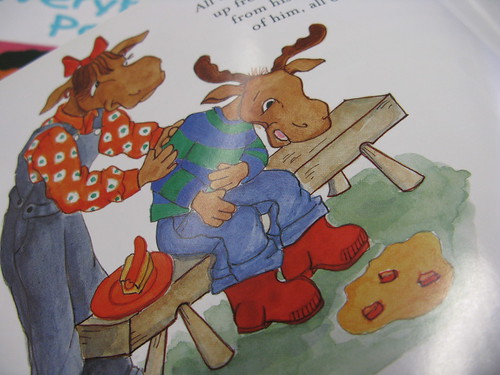
Poo books for primary school age (i.e. those passed the toilet training stage) often utalise the apparent comedic value of poo as a hook talk about wider scientific processes. The Horrible Science series is one of the best examples of this approach. We can also see it in some of the medical titles of the larger and more famous parent-series Horrible Histories too, though do note these have different author/ illustrator teams and slightly different take on what "Horrible" might mean. Snot, puke, pus and blood are equally popular subject matter here, it's not all about the shit. I think the "safe monsters" analysis is still applicable here though, and although there aren't many poo-books for teenagers, there are perhaps comparisons to be made with titles like Diary of a Teenage Healthfreak.
Horrible Science are keen to show off the use of knowledge, alongside humour, as a way of defeating fears around health issues. At the same time, they continue to draw immense delight from references to poo etc, as well as lightly spoofing the same scientific approaches to studying it which they draw power from (complex beasts, the Horrible Science books). For example, Painful Poisons (2004) starts by stating that "lots of people think poison is a scary subject". It then goes through a goading, pantomime device of implying you don’t really want this, do you, parodying a patronising adult voice and playing to the idea that this is the secret stuff kids love to read about (pages 5-6), before concluding by emphasising that poisons are everywhere and although it is "easy to be scared" the best way to deal with poisons is with knowledge rather than fear (pages 143-4). You can see similar shifts - from fears "some people" hold and towards knowledge and a delight in the horrible nature of the scientific object - in Angry Animals (2005) and Chemical Chaos (1997).
In the example below (The Body Owners Handbook, Scholastic, 2002, page 23) is possibly my favourite: a cartoon rendering of the sorts of diagrams of the digestive system frequently reproduced in school textbooks and exam papers. There is the sound of "plop" (in a friendly, handwritten-style font) along with the childish, slightly twee "poo". This is juxtaposed with comical language which pokes fun at whilst simultaneously applying the conventions of talking indirectly about excretory matter in a scientific manner; "solid waste ejection pipe", "fuel storage tank" and "conveyor belt for waste processing".
Horrible Science are keen to show off the use of knowledge, alongside humour, as a way of defeating fears around health issues. At the same time, they continue to draw immense delight from references to poo etc, as well as lightly spoofing the same scientific approaches to studying it which they draw power from (complex beasts, the Horrible Science books). For example, Painful Poisons (2004) starts by stating that "lots of people think poison is a scary subject". It then goes through a goading, pantomime device of implying you don’t really want this, do you, parodying a patronising adult voice and playing to the idea that this is the secret stuff kids love to read about (pages 5-6), before concluding by emphasising that poisons are everywhere and although it is "easy to be scared" the best way to deal with poisons is with knowledge rather than fear (pages 143-4). You can see similar shifts - from fears "some people" hold and towards knowledge and a delight in the horrible nature of the scientific object - in Angry Animals (2005) and Chemical Chaos (1997).
In the example below (The Body Owners Handbook, Scholastic, 2002, page 23) is possibly my favourite: a cartoon rendering of the sorts of diagrams of the digestive system frequently reproduced in school textbooks and exam papers. There is the sound of "plop" (in a friendly, handwritten-style font) along with the childish, slightly twee "poo". This is juxtaposed with comical language which pokes fun at whilst simultaneously applying the conventions of talking indirectly about excretory matter in a scientific manner; "solid waste ejection pipe", "fuel storage tank" and "conveyor belt for waste processing".
Possibly my favourite of the poo books is Poo: A Natural History of the Unmentionable (Walker, 2005). I think it typifies the "half euphemistic" approach to poo in many of these books. It clearly relishes poo, and yet maintains some distance from the actual object (partly by cartoon illustration, partly through dry humour). The back cover is especially nice. I hippo declares "I like to spray it all over the place", a bird sitting on it's back: "I make houses out of it". The book contains a lot of detail, and it is worth knowing that the author, Nicola Davies is a zoologist who used to present the Really Wild Show. Note the "natural history" in the title (and white-coated characters on cover). Like Horrible Science, this is a step along from toilet training and seems to self-consciously play with the humour of the serious and detached way science might deal with "poo" just as much as any other humour in the subject.
Maybe it's not surprising I like this book. As with a lot of poo books, it seems to appeal to grown ups as well as children. I have a copy because it was a birthday present (a birthday in my mid-20s). Indeed, this article from the New York Times about the US publishers of Everybody Poos notes the books are popular with adults buying for other adults.
Arguably, this is true of a lot of children's books (see also point on the "impossiblity" of children's media and "generational drag" in latter half of this blogpost). The idea that children will like the yuk of poo and snot and pus is just an adult's idea of childishness, one that it is interesting to have seen shift slightly in the last century. As I argue in my PhD on Horrible Science, they seem to have roots in a rather Beano idea of childhood. In his 1989 book about working at the Beano, On Comedy: The "Beano" and Ideology, Leo Baxendale, creator of the Bash Street Kids and Minnie the Minx, talks of a desire to depict what he felt was a truer, "scruffier" and more anarchic image of children, in contrast to "soft" fairytale images he felt the Beano applied up until the 1950s. For Horrible Histories author Terry Deary, the social acceptability of the Horribles is largely due to the legacy of Roald Dahl who, according to Deary, made the use of horror and black comedy in children’s books acceptable (Deary, 1999: 97). Considering that historical background I thought it was interesting that the NYT article referenced criticisms that poo-books aren't very American. I've noticed that Grossology is a lot milder than Horrible Science (and the Horrible books have never really made it in the USA). Maybe, despite the various efforts of Warner Brothers, Nickleodeon and the Simpsons, the more anarchic image of childhood is still less acceptable in the USA.
A final point prompted by the Horrible Science books: we live in a multi-media age, and kids science books are, generally, a rather interactive form of "dead-tree" publishing. So, yes, finally, we have the mini-sub-genre of "hands-on" poo books. Obviously, such hands-on interaction is heavily mediated. They don't actively ask their readers to handle their faeces. For example, Horrible Science's Disgusting Digestion sticker book (Scholastic, 1998) includes a set of stickers of partially (and not so partially) digested food for you to place along their cross-section diagram of the gut.
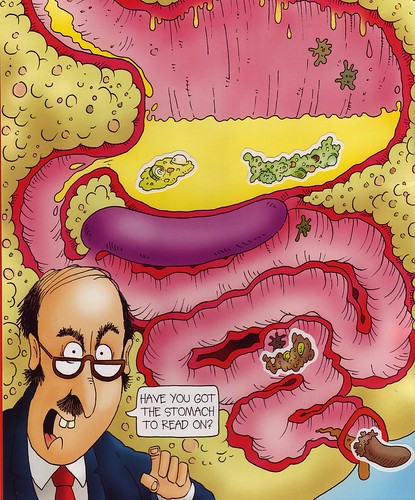
It is worth noting that this is true of most so-called hands on interaction in kids science. Whatever their appeal to immediacy, most so-called "experiments" are mock-ups of demonstrations. It isn't just shit which science books for kids feel a need to fabricate. This is often for quite sensible educational and practical reasons, but worth baring in mind. I think I've saved the best till last. Because the book Farley Farts (2003) does actually fart, albeit annoying softly. Play this little video to hear it.
This post has been largely descriptive. If you're interested in slightly more academic analysis, I can recommend Mills, Alice (2006) ‘Harry Potter and the Terrors of the Toilet’, Children’s Literature in Education, vol 37(1), 1-13. I think Mills nails the differences between boys and girls toilets as dramatic sites in children's books: Girls toilets, she argues, are relatively private and thus places of solace, where characters go to escape on their own; Boy's bogs are more um, 'communal' and full of fighting, pain and suffering. The rest is a bit too psychoanalytic for my personal taste, but if you like a serving of Kristeva's idea of the abject with your literacy analysis (and/ or the odd bit of Harry Potter studies), it's a peach of a paper.
I'll leave you with a tip for anyone reading this post on the toilet, from the charming Liam goes Poo in the Toilet (2008, subtitle: A Story about Trouble with Toilet Training). Sage advice at any age, I'd say.
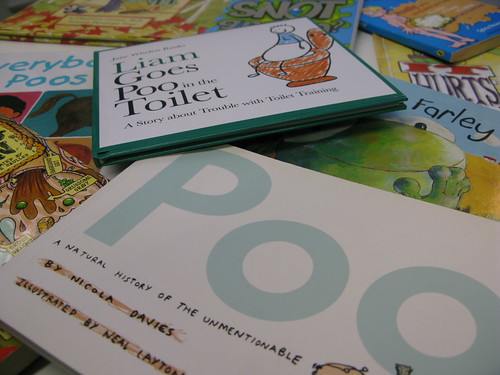

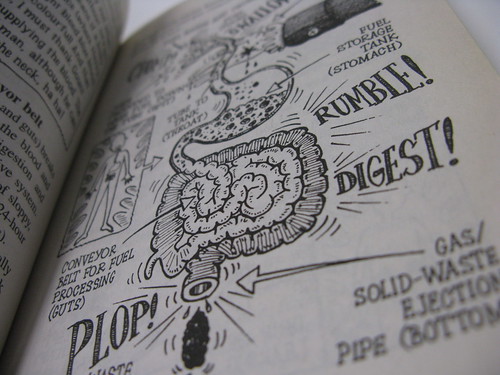
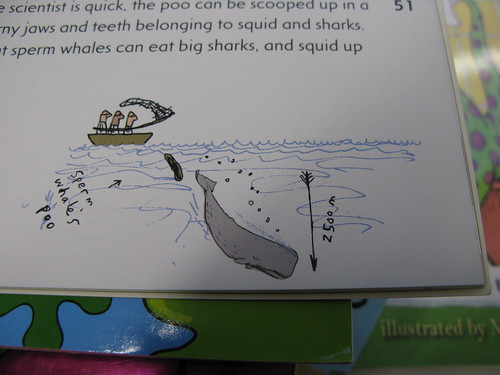
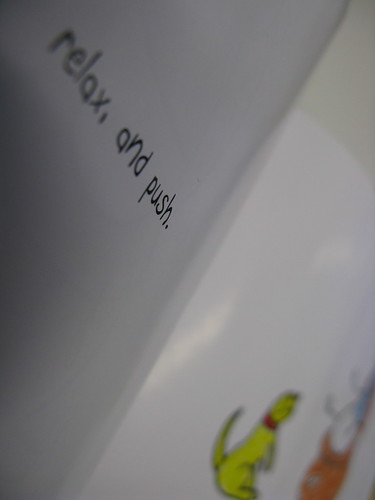

This is a fascinating post!
ReplyDeleteThis weekend my brother-in-law was sporting a t-shirt given to him by a laxative manufacturer with a pictorial guide to correct "bowel-emptying" position on the back.
"Run, Run, It's Scary Poo!" Is one of our favourite Poo Books, although it's function is somewhat different; highlighting the use of poo as a territory mark or environment sensing clue.
ReplyDeletethis seemed funnier and sweeter before i had to unblock the drain at the weekend. there was months' worth down there. that said, i will still buy my lil daughter a good poo book.
ReplyDeleteMarvellous survey. The first book of this kind that I can remember reading is 'The Body Book' by Claire Raynor. Poo appeared only briefly, but there was an image of a child on a toilet from the toilet water's point of view that reduced my sister and I to helpless giggles.
ReplyDeleteNicola Davies' book is wonderful. I picked it up recently and loved every humorous, informative page. Easy to see how kids would delight in it, the more so because poo is such an everyday fascination, and one of deep ecological significance, but which adults tend to ignore, or even pooh-pooh.
Where you write that 'The Moose with the Loose Poops' comes with a "pull-out medical guide", I misread that at first as "pop-out", as in pop-up. Hmm. There's a publishing idea. But the last photo — I thought pushing was a bad idea?
Stan - yes, I have a copy of The Body Book too. A classic. I really wish I could get the Wellcome Trust to put on an exhibition of illustrations in 20thC kids' body books. Amazing stuff. That and the Robots in the Usborne How Your Body Works.
ReplyDeleteAs for popup - somewhere pop-up poo has already been done, I'm sure. If there's a sticker book, there must be popup, and there is that popup gut I link to in the post.
Hi,
ReplyDeleteI'm a publishing student and I'm writing about taboos in publishing children's books. I wondered if you have any views on these types of books being used in schools? Do you think teachers should introduce these types of books to their young students? How do you think parents would feel about this?
Your ultimate skill can provide each combo points cheap wow gold by seven to twenty percent of chance to make your next cast time less than ten seconds of the natural spells become instant. Primitive rage can cause a deadly blow to buy rs gold the target when you are bear and dire bear form.
ReplyDeleteThere Cheap D3 Gold stays only inquiries as well as experiment with. Communicating guide. You must look the following, not necessarily puppies, bunnies along with test subjects to be named quite the hero. Quite GW2 Gold, it goes right to the point, for that ultimate party event keeps the solid businesses willing to apply it completed.
ReplyDeleteThe Last of Us has received tremendous praise since fifa coin traders embargo lifted earlier this month, and currently sits at 95/100 on Metacritic. Funny enough, we scored it a 9.5/10 here on GameZone. But as buy fifa ultimate team coins sit here and praise the latest hit from Naughty Dog, fifa 13 münzen kaufen can't help but wonder what's in store for upcoming PS4 owners. Although nothing was announced at E3, you know Naughty Dog has something up their sleeve for next-gen.But Sony wasn't the only one to enjoy the week.
ReplyDelete